Here is a possible way you can approach your problem.
First, in order to use ox.plot_graph with your randomly generated graph, you'll need to know what type of graph ox.plot_graph takes as input. From the documentation here, it looks like a nx.MultiDiGraph si waht you need (doc here).
Next, you can randomly generate a directed graph with H=nx.gnp_random_graph(100, 0.1, seed=None, directed=True) for instance. Note that Networkx offers a lot of graph generation functions (see here) so just pick the one that works best for you.
In your next step, you can cast your graph from nx.DiGraph to nx.MultiDiGraph by using I=nx.MultiDiGraph(H).
You now have a random nx.MultiDiGraph. In order to draw the graph in your polygon you need to associate to each node a x and y coordinate sampled from within the polygon. I did that using the answer in this SO post
You can then link these positions to your nodes following osmnx syntax by running:
for i,node in enumerate(I.nodes(data=True)):
node[1]['x']=pos[i][0]
node[1]['y']=pos[i][1]
As of now, the only thing missing for this to work is associate a crs to your random graph. ox.plot_graph seems to be requiring it. A simple workaround is to use the one generated for the osmnx graph G in your example.
I.graph={'crs':'epsg:4326'}
Finally, you can plot your graph and your polygon (see here for how to plot shapely object with matplotlib):
x,y = p.exterior.xy
fig,ax=ox.plot_graph(I,show=False, close=False, edge_color='black', bgcolor='w', edge_alpha=0.5, node_color='black')
ox.utils_graph.remove_isolated_nodes(I)
ax.plot(x,y)
ax.set_xlim([-96.9,-96.6])
ax.set_ylim([32.82,33.02])
plt.show()

See full code here:
from shapely import geometry
from shapely.geometry import Point
import matplotlib.pyplot as plt
import numpy as np
import networkx as nx
import osmnx as ox
# (lat, long) coordinates
p1 = geometry.Point(-96.87,32.88)
p2 = geometry.Point(-96.77,33.00)
p3 = geometry.Point(-96.67,32.95)
p4 = geometry.Point(-96.65,32.84)
pointList = [p1, p2, p3, p4, p1]
# creat geometric object
p = geometry.Polygon([[p.x, p.y] for p in pointList])
H=nx.gnp_random_graph(100, 0.1, seed=None, directed=True) #step 2
I=nx.MultiDiGraph(H) #step 3
def random_point_in_shp(shp): #step 4
within = False
while not within:
x = np.random.uniform(shp.bounds[0], shp.bounds[2])
y = np.random.uniform(shp.bounds[1], shp.bounds[3])
within = shp.contains(Point(x, y))
return [x,y]
pos=[random_point_in_shp(p) for _ in range(100)]
for i,node in enumerate(I.nodes(data=True)): #step 5
node[1]['x']=pos[i][0]
node[1]['y']=pos[i][1]
I.graph={'crs':'epsg:4326'} #step 6
x,y = p.exterior.xy #step 7
fig,ax=ox.plot_graph(I,show=False, close=False, edge_color='black', bgcolor='w', edge_alpha=0.5, node_color='black')
ox.utils_graph.remove_isolated_nodes(I)
ax.plot(x,y)
ax.set_xlim([-96.9,-96.6])
ax.set_ylim([32.82,33.02])
plt.show()
EDIT: Example with a 3-neighbors graph (60 nodes, 180 edges)
The core of the process is the same. The difference comes from creating the node position before the graph. And then, use the lypysal weights.KNN function to connect nodes with their 3 closest neighbors as in the link you provided in comments (here). The graph can then be turned into a nx.MultiDiGraph and the rest is the same.
from shapely import geometry
from shapely.geometry import Point
import matplotlib.pyplot as plt
import numpy as np
import networkx as nx
import osmnx as ox
import libpysal
# (lat, long) coordinates
p1 = geometry.Point(-96.87,32.88)
p2 = geometry.Point(-96.77,33.00)
p3 = geometry.Point(-96.67,32.95)
p4 = geometry.Point(-96.65,32.84)
pointList = [p1, p2, p3, p4, p1]
# creat geometric object
p = geometry.Polygon([[p.x, p.y] for p in pointList])
def random_point_in_shp(shp): #step 4
within = False
while not within:
x = np.random.uniform(shp.bounds[0], shp.bounds[2])
y = np.random.uniform(shp.bounds[1], shp.bounds[3])
within = shp.contains(Point(x, y))
return [x,y]
N_nodes=60
pos=[random_point_in_shp(p) for _ in range(60)]
#create 3-neighbor graph
kd=libpysal.cg.KDTree(np.array(pos))
knn3=libpysal.weights.KNN(kd, k=3)
knn_graph = knn3.to_networkx()
K=nx.MultiDiGraph(knn_graph)
for i,node in enumerate(K.nodes(data=True)): #step 5
node[1]['x']=pos[i][0]
node[1]['y']=pos[i][1]
K.graph={'crs':'epsg:4326'} #step 6
x,y = p.exterior.xy #step 7
fig,ax=ox.plot_graph(K,show=False, close=False, edge_color='black', bgcolor='w', edge_alpha=0.5, node_color='black')
ox.utils_graph.remove_isolated_nodes(K)
ax.plot(x,y)
ax.set_xlim([-96.9,-96.6])
ax.set_ylim([32.82,33.02])
plt.show()




